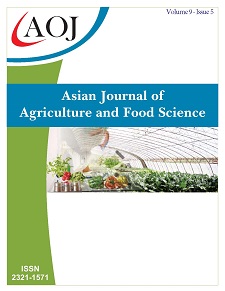Use of Antiviral Virucides in the Prevention of Some Viral Diseases Causing on Tobacco Plants in Vietnam
DOI:
https://doi.org/10.24203/ajafs.v10i5.6796Keywords:
Disease, tobacco, viral disease, antiviral agent, virucidesAbstract
In recent years, some viral diseases have been increasing in the tobacco-growing regions of Vietnam and cause serious damage to the tobacco yield and quality. If it has not an effective control, viral diseases will injure seriously in the tobacco field in next time. To control the effect of viral diseases, study use of some antiviral virucides is necessary on tobacco plants. In 2021, Vietnam Tobacco Institute experimented with the effective control of Ditacin 8SL, Sat 4SL, and Exin 4.5SC for TMV, CMV, PVY, and TNRV on the tobacco field in Bac Giang province. Results of the study show the antiviral agents are effective in the control of the virus disease on tobacco. When only spray Ditacin 8SL, effective prevention for viral diseases ranges from 22.4 - 30.3%; Sat 4SL: 5.5 - 30.2%, and Exin 4.5SC: 8.2 - 24.1%. Spraying a mixture of antiviral agents and insecticides gives higher efficiency than spraying a kind. For example, spray Ditacin 8SL + Confodor 100SL, effective control reaches from 34.3 to 100%; Sat 4SL + Confidor 100SL: 32.6 - 92.3, and 38.5 - 100% with Exin 4.5SC + Confidor 100SL. The spray treatments have a higher yield and quality than the control without spraying.
References
Mengnan An, Xiuxiang Zhao, Tao Zhou, Guanzhong Wang, Zihao Xia, Yuanhua Wu. 2019. A Novel Biological Agent Cytosinpeptidemycin Inhibited the Pathogenesis of Tobacco Mosaic Virus by Inducing Host Resistance and Stress Response. J Agric Food Chem, 2019 Jul 10;67(27):7738-7747. PMID: 31199650. DOI: 10.1021/acs.jafc.9b02662.
Boualem, A., Dogimont, C. & Bendahmane, A. 2016. The battle for survival between viruses and their host plants. Curr. Opin. Virol. 17, 32–38, https://doi.org/10.1016/j.coviro.2015.12.001.
Nguyen Van Chin, Do Thi Thuy, Phung Thi Hay, Nguyen Van Van, Tao Ngoc
Tuan, Nguyen Quoc Tuan, and Nguyen Van Cuong. 2021. Estimating The Effective Control of Ditacin 8 SL, and Sat 4SL with Tobacco Mosaic Virus (TMV), Cucumber Mosaic Virus (CMV), and Potato Virus Y (PVY) on Tobacco Plants. Journal of Science and Technology, Vol. 06, Issue 03, May-June 2021, pp80-87.
Hoseong Choi, Yeonhwa Jo, Won Kyong Cho, Jisuk Yu, Phu-Tri Tran, Lakha Salaipeth, Hae-Ryun Kwak, Hong-Soo Choi and Kook-Hyung Kim, 2020. Identification of Viruses and Viroids Infecting Tomato and Pepper Plants in Vietnam by Metatranscriptomics. Int. J. Mol. Sci. 2020, 21(20), 7565; https://doi.org/10.3390/ijms21207565.
Florence Faurez, Thomas Baldwin, Michel Tribodet, and Emmanuel Jacquot. 2012.Identification of new Potato virus Y (PVY) molecular determinants for the induction of vein necrosis in tobacco. Mol Plant Pathol. 2012 Oct; 13(8): 948–959. PMCID: PMC6638754. https://doi.org/10.1111/j.1364-3703.2012.00803.
German TL, Ullman DE, Moyer JW. 1992. Tospoviruses: diagnosis, molecular biology, phylogeny, and vector relationships. Annu Rev Phytopathology 30:315–34
Palukaitis, P. & García-Arenal, F. 2003. Cucumoviruses. Adv. Virus Res. 62, 241–323.
Channarong Seepiban, Oraprapai Gajanandana, Tipvadee Attathom, Supat Attathom, 2011. Tomato necrotic ringspot virus, a new tospovirus isolated in Thailand. Arch Virol. 2011 Feb;156(2):263-274. PMID: 21104282. DOI: 10.1007/s00705-010-0856-0.
Ziwen Wang, Anzheng Feng, Mingbo Cui, Yuxiu Liu, Lizhong Wang, Qingmin Wang. 2012. First Discovery and Structure-Activity Relationship Study of Phenanthroquinolizidines as Novel Antiviral Agents against Tobacco Mosaic Virus (TMV). PLOS ONE 7(12) 2012, e52933. PMID: 23285230. DOI:10.1371/journal.pone.005293.
Yueyan Yin, Kuanyu Zheng, Jiahong Dong, Qi Fang, Shiping Wu, Lishuang Wang, and Zhongkai Zhang, 2014. Identification of a new tospovirus causing necrotic ringspot on tomato in China. Virol J. 2014; 11: 213. PMID: 25465801. Published online 2014 Dec 3. DOI: 10.1186/s12985-014-0213-0.
Zainab F. Al-Hashimi; Ragad N. Al-Khashab; Nabeel A. Kassim. 2010.Impact of salicylic acid and liquid fertilizers on the productivity of PVY-infected potato plants.Rafidain Journal of Science, 2010, Volume 21, Issue 5, Pages 73-82. DOI:10.33899/rjs.2010.37006.
Zhao L, Feng C, Hou C, Hu L, Wang Q, Wu Y (2015). First Discovery of Acetone Extract from Cottonseed Oil Sludge as a Novel Antiviral Agent against Plant Viruses. PLoS ONE 10 (2): e0117496. doi:10.1371/journal.pone.0117496.
Downloads
Published
Issue
Section
License
Copyright (c) 2021 Chin Nguyen Van, Nguyen Van Van, Tào Ngọc Tuấn, Dương Xuân Diêu, Phạm Hà Thành, Phung Thi Hay, Nguyen Van Cuong

This work is licensed under a Creative Commons Attribution-NonCommercial 4.0 International License.
Copyright © The Author(s). This article is published under the Creative Commons Attribution License (CC BY 4.0), which permits unrestricted use, distribution, and reproduction in any medium, provided the original work is properly cited.


